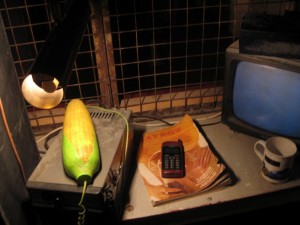You are in the HEROIN ROOM. You can see: a painting, a broken chair, a lighter and some tin foil. There are exits: SE, SW. What do you want to do? _
That’s not meant to be the worst dropped intro ever written, but a faithful reproduction of the game-like dynamics of one of Mike Nelson’s most labyrinthine works.
Because for visitors of a certain age, making their way through the 14 rooms here is reminiscent of the text-based adventures which came on 80s computers. What do you see? Which way next?
The video game experience seems fully intended. Somewhere near the heart of The Coral Reef is a vintage arcade machine, an obscure platformer called Black Magic.
And there is something magical about the way you can interact with this work, and certainly something dark about the world which Nelson has created. Yet it’s as comic as pixels and bleeps.
These days, seventh generation console games let you explore virtual worlds in ways we could not have dreamed of. But none compare with Nelson’s sculpture for potential suspended disbelief.
So this blogger even went so far as to spend 15 disoriented minutes making a map. It looks a bit like a medieval mappa mundi, and it does contain spoilers, but get in touch if you’d like a pdf.
All I can say is it was a shock to find so many political, religious and cultural extremists were living in such proximity. If we can get lost in a sculpture, we stand no chance in the world at large.
Find out why Jonathan Jones said this work was “one of the true masterpieces of modern British art†by reading his 2010 blog post in the Guardian. Meanwhile Art Safarist Ben Davis rates Nelson’s chances of winning a Golden Lion at Venice this year.
Unsurprisingly, this is one of the most blogged about pieces of art I have come across. For some good photos, check out Corinna Spencer’s.
The Coral Reef can be seen as part of Tate Britain’s current display of Contemporary Acquisitions. And the gallery advise you to check it’s on view before visiting (or you could live dangerously).

No Comments